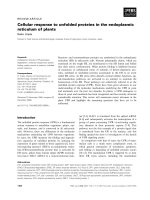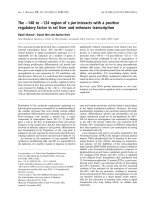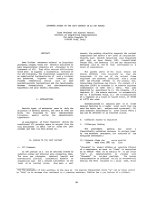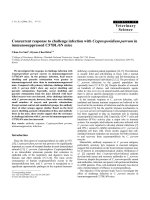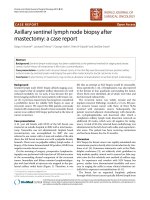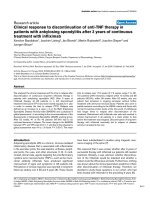báo cáo khoa học: " Clinical response to Auron Misheil Therapy in a man with advanced multifocal hepatocellular carcinoma: A case report" ppsx
Bạn đang xem bản rút gọn của tài liệu. Xem và tải ngay bản đầy đủ của tài liệu tại đây (854.61 KB, 6 trang )
CAS E REP O R T Open Access
Clinical response to Auron Misheil Therapy in a
man with advanced multifocal hepatocellular
carcinoma: A case report
Jürgen S Scheele
1*
, Jan Harder
2
, Zoran Stankovic
3
, Daniel Räpple
1
, Annette Dorn
1
, Hans C Spangenberg
4
and
Hubert E Blum
1
Abstract
Introduction: Auron Misheil Therapy was developed based on similarities between carcinogenesis and
inflammation. Auron Misheil Therapy is a combination of natural and synthetic compounds, including anti-
inflammatory drugs and insulin, expected to exhibit synergistic effects.
Case presentation: Here, we report the case of a 78-year-old Caucasian male patient who presented with
multifocal hepatocellular carcinoma and chronic hepatitis C virus infection. Over a four-year period our patient was
treated wi th radiofrequency ablati on and transarterial chemoembolization. After these treatments the re was tumor
progression, with new hyperperfused lesions without evidence of extrahepatic tumor involvement. Our patient
refused sorafenib therapy. Therefore, he received twice daily intramuscular injections of Auron Misheil Therapy on
an outpatient basis for two months. Partial remission of the hepatic lesions was observed eight weeks after the
start of treatment, and confirmed four weeks later. Unfortunately, at that time our patient refused therapy due to
dizziness. During follow-up two target lesions remained stable, but one lesion increased in size. At the latest
follow-up, one year later, there was still tumor control.
Conclusion: While the mechanisms underlying the antitumor effects of Auron Mishe il Therapy are not fully
understood, stable disease and remissions have been observed in different types of tumors, including
hepatocellular carcinoma.
Introduction
Hepatocellular carcinoma (HCC) is currently the fifth
most common tumor, with 500,000 to one million new
cases worldwide per year an d 600,000 deaths [1]. In
Western countries over 80% of HCCs arise in a cirrhotic
liver. Cirrhosis in a setting of chronic liver cell injury,
with inflammation, hepatocyte necrosis and regenera-
tion, is a major r isk for hepatocyte dedifferentiation and
HCC development [2,3]. HCCs are often asymptomatic
during early stages. Therefore, the majority of patients
(over 80%) show advanced disease or unresectable
tumors. Even after successful resection, the recurrence
can be as high as 50% at two years [4]. HCCs are mostly
resistant to chemotherapy [5,6] and express the
multidrug-resistant gene MDR-1 [7]. Unfortunately,
effective treatment options for advanced HCC are still
limited, despite numerous clinical studies with most
chemotherapeutic agents. Response rates are low and
the response duration is typically short [8,9]. Currently,
sorafenib is the only licensed therapy for the treatment
of advanced HCC [ 10]. Recent advances in the under-
standing of molecular hepatocarcinogenesis include key
carcinogenic pathways, such as increased angiogenesis,
aberrant signal transduction and dysregulated cell cycle
control [11-14].
HCC often develops in as sociation with c hronic liver
inflammation caused by different risk factors, such as
either hepatitis B or C virus infection, alcohol-induced
liver injury or obesity-induced fat accumulation. Asso-
ciated with most HCC risk factors is an increased circu-
lating interleukin-6 (IL-6) level that functions, amongst
* Correspondence:
1
Department of Hematology and Oncology, University Medical Center
Freiburg, Hugstetter Strasse 55, 79106 Freiburg, Germany
Full list of author information is available at the end of the article
Scheele et al. Journal of Medical Case Reports 2011, 5:478
/>JOURNAL OF MEDICAL
CASE REPORTS
© 2011 Scheele et al; licensee BioMed Cen tral Ltd. This is an Open Access article distributed under the terms of the Creative Commons
Attribution License (http://creative commons.org/licenses/by/2.0), which permits unrestricted use, distribution, and reproduction in
any medium, provided the original work is properly cited.
other factors, as the best predictor of rapid progression
from viral hepatitis to HCC in humans [15].
Since proliferation and angiogenesis resemble wound
healing and inflammation, anti-inflammatory agents
have been evaluated as antitumor agents. In this context,
Auron Misheil Therapy (AMT) was developed to add to
the existing cancer treatment options. AMT is a fixed
combination of aqueous chamomile extract supplemen-
ted with calcium, vitamins, the antihistamine chlorphe-
niramine and human insulin. Gender (men have a
higher risk than women), obesity and diabetes are HCC
risk factors, and this seems to be due to alterations i n
the metabolism of endogenous hormones, including sex
steroids, insulin and the insulin-like growth factor (IGF)
and IGF receptor (IGFR) system [16]. AMT was tested
against 56 human tumor cell lines in vitro, in a clono-
genic assay in 98 patient-derived xenografts, and in in
vivo studies [17]. In vitro cytotoxic activity was highest
in cervical canc er and colon cancer as w ell as in glio-
blastomas. In vivo, AMT showed some antitumor activ-
ity in tumor xenograft models of colon and mammary
cancer, and in immune stimulation via induction of IL-6
and tumor necrosis factor (TNF)-alpha in human per-
ipheral blood mononuclear cell (PBMCs) [18]. Clinical
pilot studies have been initiated i n women with
advanced cervical cancer and in p atients with various
solid tumors. Since data from large clinical trials are not
yet available, case re ports may provide evidence for suc-
cessful use of AMT.
Case Presentation
A 78-year-old male Caucasian patient presented at our
clinic with multifocal HCC in a cirrhotic liver, Child A
due to HCV genotype I infection. Prior to AMT treat-
ment our patient was treated with radiof requency abla-
tion (RFA) and four transarterial chemoembolizations
(TACE) over a four-year period. Due to tumor progres-
sion, further TACE or local ablation therapies were no
longer viable.
At that time our patient refused sorafenib therapy du e
to the well documented side effects, such as fatigue,
diarrhea, hand-foot- syndrome and others. Therefore, he
wasincludedinanongoingAMTtrial.Physicalexami-
nation revealed an enlarged liver, no clinical signs of
ascites or hepatic encephalopathy, no peripheral edema
but a slight scleral icterus. Laboratory tests showed a
normal blood count, an international normalized ratio
of 0.95, albumin 3.5g/dL, bilirubin 1.9 mg/d L, aspartate
transaminase 148U/L and alanine transaminase 96U/L.
His a-fetoprotein level was elevated (29.5ng/mL) and
remained so throughout follow-up.
Twice daily intramuscularinjectionsofAMTwere
started on an outpatient basis for two months.
A baseline computed tomography (CT) scan of his
abdomen performed prior to the ini tiation of AMT
identified thre e target lesions (TL ) that fulfilled the
Response Evaluation Criteria In Solid Tumors (RECIST)
criteria. Two lesions had increased in size since the pre-
vious CT scan of his abdomen, performed two months
before at the end of the last treatment (Figure 1). TL1
was situated in t he right dorsal l iver margin, segment 8,
and measured 20 mm (previously 12 mm). TL2 was in
the right lateral margin of segment 4b, and measured 12
mm (no change f rom previous CT). TL3 was in t he
anterior margin of segment 4b, and m easured 12 mm
(previous 6 mm).
Therightliverlobeshowed marked atrophy, whereas
the left lobe revealed hypertrophy. No extrahepatic man-
ifestations were discovered. His peri-aortacaval lymph
nodes were slightly enlarged.
After eight weeks of AMT treatment th e first tumor
staging was performed and his abdomen and chest CT
scans showed a partial remission. Both target lesions T1
and T2 had disappeared. TL3 had shrunk to 7 mm (40%
reduction) with a contrast medium enhancement in the
boundary area of the lesion. Again, no extrahepatic
involvement was discovered (Figure 2).
According to RECIST, remission has to be c onfirmed
by a second scan at least four weeks later. This scan
confirmed the partial remission. The HCC volume in
his liver had further decreased with unchanged mor-
phology, in other words, atrophy of the r ight lobe and
hypertrophy of the left lobe. TL1 and TL2 were still
invisible, wh ile TL 3 was unchanged in size. In his chest
CT scan there was no evidence of lung metastases.
Figure 1 Baseline CT abdomen scan. Early arterial examination
time, showing liver cirrhosis after transarterial chemoembolization
with hypotrophy of his right liver lobe and hypertrophy of his left
liver lobe. Lipiodol remnants in the right lobe. Arrow: TL1 in
segment 8, size 20 mm.
Scheele et al. Journal of Medical Case Reports 2011, 5:478
/>Page 2 of 6
Neither bone involvement nor any other extra hepatic
manifestation was discovered. Our patient complained
about dizziness during AMT and requested to terminate
treatment.
Six weeks later, a CT scan revealed several new early
arterial hyperperfusion areas in both lobes of his liver,
for example, a lesion with 24 mm diameter was found
at the right dorsal margin of segment 8. The two
defined lesions TL1 and TL2 that had been in complete
remission remained in remission. TL3 that had been in
part ial remission had increased in size to 16 mm. Adre-
nal involvement wa s suspected, but lung, spleen, kidney,
bones and lymph nodes were free of metastases. Unfor-
tunately, our patient refused to restart AMT de spite the
remarkable previous tumor control.
Three months later, a follow-up CT scan showed con-
tinued tumor control. TL3 had again disappeared,
despite having shrunk and re-grown in the preceding
months. The other lesions TL1 and TL2 rema ined in
remission. The adrenal metastasis was unchanged and
no further tumor progress was observed.
Again, three months after that, progressive disease was
once again documented by CT with recurrence of TL3
with a size of 11 mm and several new lesions in both
liver lobes up to 22 mm (Figure 3). There were no new
extrahepatic metastases except for the adrenal lesion
that was unchanged in size. Our patient now agreed to
sorafenib therapy.
Discussion
This case demonstrates that the HCC regression in this
patient was closely r elated to AMT. At week eight of
AMT, HCC remission was evident and continued for
some time after the treatment was stopped. Not surpris-
ingly, HCC recurred after withdrawal of the treatment.
While the molecular basis of the efficacy of AMT is not
known in detail, inflammation and immune activation
modulated by stress-responsive pathways may b e
involved [18]. Diverse cellular functions, ranging from
differentiation and proliferation to migration and
inflammation, are regulated by mitogen-activated pro-
tein kinase (MAPK) signaling. The pathway modulates
numerous cellular responses through a wide range of
activating factors [19]. Pro-tumoral inflammation and
the role of intrinsic, oncogene-driven pathways have
also been described [20]. In addition, inflammatory pro-
cesses as well as the epithelial-mesenchymal transitions
occur in HCC cells to facilitate their dissemination and
are related to cell survival [21].
A central event for the induction of chronic liver dis-
ease and the promotion of liver fibrosis, and likely for
liver cancer, is inflammation [22]. It has been shown
that at least 20% of all cancers developed a s a conse-
quence of infection and chronic inflam mation. But even
cancers not induced in association with chronic inflam-
mation show extensive inflammatory infiltrates, with
high cytokine expression levels in the tumor microenvir-
onment [23]. Amongst these cytokines are growth and
survival factors that act on premalignant cells [24], sti-
mulate angiogenesis, tumor progression and metastasis,
and also maintain tumor-promoting inflammation
[25-27]. Pro-inflammatory cytokines, such as TNF and
IL-6, can influence all stages of tumor development,
including initiation, promot ion, progression and metas-
tasis [28,29]. In more than 50% of all cancers, an aber-
rant activation of nuclear factor kappa-light-chain-
enhancer of a ctivated B cells and/or signal transducer
and activator of transcription 3 is found, which makes
premalignant and fully transformed cells resistant to
Figure 2 Control CT abdomen scan after eight weeks of AMT
treatment. Early arterial examination time, showing liver cirrhosis
after transarterial chemoembolization. TL1 disappeared.
Figure 3 Follow up CT scan six months later. Early arterial
examination time scan revealing recurrence of TL3, size 11 mm
(arrow) and a new lesion next to a cyst of size 12 mm in liver
segment 4b (arrow head).
Scheele et al. Journal of Medical Case Reports 2011, 5:478
/>Page 3 of 6
apoptosi s and induces their rate of proliferation, thereby
increasing tumor growth [27,30].
Furthermore, necrotic cells, which release their con-
tents– including pro-inflammatory signals– into the sur-
rounding tissue microenvironment, can recruit
inflammatory cells of the i mmune system, which a re
capableofsurveyingtheextentoftissuedamageand
removing associated necrotic debris [23]. There is evi-
dence that these immune inflammatory cells can be
actively tumor-promoting by fostering angiogenesis, can-
cer cell proliferation and invasiveness [23].
Anti-inflammatory activities, especially t hose resulting
from natural compounds rather than chemicals, may
interfere with one or several pathways. AMT contains
both natural (chamomile extract) and chemically defined
(chlorpheniramine) anti-inflammatory compounds.
The major antiproliferative effect of AMT is mediated
by the chlorpheniramine component. Among other
mechanisms, chlorpheniramine and structurally related
compounds control proliferation b y binding to the
translationally controlled tumor protein [31]. Like AMT,
octreotide functions through multiple mechanisms and
receptors inhibiting several secretory and proliferative
responses. Within this process, G-protein coupled
receptors play a central role by dis rupting diverse signal
transduction pathways like inhibition of adenylate and
guanylate cyclase, modulation of ionic conductance
channels and protein dephosphorylation [32]. Somatos-
tatin and its analogues inhibit not only the proliferation
of normal and neoplastic cells [33,34], including the
hepatocellular cell lin e Hep G2 [35], but also a variety
of experimental tumors. This is mediated by the inhibi-
tion of growth arrest through the modulation of MAPK
and the induction of G1 cell cycle arrest, as well as by
an apoptotic effect through activation of p53 and Bax
protein. These actions are mediated directly by somatos-
tatin receptors present on tumor cells and indirectly via
somatostatin receptors located on non-tumor cell targets
[36,37].
Furthermore, several l ines of evide nce indicate a role
of insulin, IGF and its receptor IGFR in hepatocarcino-
genesis [13,14,16,17]. In particu lar, the Ras /Raf-pro tein
family seems to play a major role in HCC development.
This intracellular signaling pathway involves ligands
bindi ng to tyrosine kinase receptors, such as the epider-
mal growth factor receptor and the IGFR. This activates
Ras, which in turn activates serine threonine kinases of
the Raf-family [38]. Pre-clinical studies of AMT demon-
strated cytotoxic activi ty in a variety of tumor types. As
discussed, AMT has shown in vivo some antitumor
activity in tumor xenograft models of breast and colon
cancer as well as immune stimulatory effects in human
PBMCs [17]. Clinical studies of AMT are only at their
beginning, but tend to confirm the preclinical data. In a
pilot study in women with advanced cervical cancer,
AMT was well tolerated and improved the quality of life
[39]. Interestingly, the presented patient complained
about dizziness during AMT treatment. The overall
adverse events (AE) of AMT were investigated in an
interim analysis, in which no relevant differences were
observed between the AMT groups and the placebo
group. Under treatment with AMT, approximately one-
quarter of the patients experienced AEs (single-blinded
AMT: five out of 21 patients (23.8%) experienced 14
events; open AMT: four out of 14 patients (28.6%)
experienced five events), involving hypoglycemia, eosino-
philia, injection site pain, sciatica and rash. The majority
of these events (11 of the 19 events classified as being
possibly related to AMT) were rated as mild to moder-
ate. The remaining events were classified as severe
(seven events, all hypogl ycemia) or life-t hreatening (one
event: hypoglycaemia; also to be classified as serious).
Two of these 19 events were classified as ‘serious’ (both
hypoglycemia). The outcome of all 19 events was ‘recov-
ered without sequelae’. With the exception of eosinophi-
lia (one mild event) the other AEs describ ed above as
being possibly related to the study drug are largely con-
sistent with the known safety profile of AMT.
In patient s with stage IIIb or IVa cervical cancer eight
out of fifteen (53%) we re clinical responders at week 12.
One p atie nt had a partial r espon se and 11 patients had
stable disease based on RECIST criteria.
Our patient participated in a phase II study of AMT
in patients with various solid tumors. Pivotal clinical
data on the efficacy of AMT thus tend to support the
concept of pleiotropic effects that might also explain the
efficacy in different types of tumors.
Conclusion
Within this case report a stable disease and remissions
have been observed in HCC, although the mechanisms
of the a ntitumor effects of AMT are n ot fully under-
stood. Patients with advanced HCC need not only an
effective therapy, but one which does not affect liver
function given the preexisting cirrhosis. In this context,
AMT might be a therapeutic alternative, with little toxi-
city compared to cytostatic drugs , prov ided that its effi-
cacy is confirmed in randomized clinical HCC trials.
However, more results from controlled clinical trials
with AMT are needed in order to substantiate this pos-
sible treatment alternative.
Consent
Our patient died in the interim, and written informed
consent was obtained from the patient’s wife for publi-
cation of this case report and accompanying images. A
Scheele et al. Journal of Medical Case Reports 2011, 5:478
/>Page 4 of 6
copy of the written consent is available for review by the
Editor-in-Chief of this journal.
Abbreviations
AE: adverse event; AMT: Auron Misheil Therapy; CT: computed tomography;
HCC: hepatocellular carcinoma; IGF: insulin-like growth factor; IGFR: insulin-
like growth factor receptor; IL-6: interleukin-6; MAPK: mitogen-activated
protein kinase; PBMC: peripheral blood mononuclear cell; RECIST: Response
Evaluation Criteria In Solid Tumors; TACE: transarterial chemoembolization;
TL: target lesion; TNF: tumor necrosis factor.
Author details
1
Department of Hematology and Oncology, University Medical Center
Freiburg, Hugstetter Strasse 55, 79106 Freiburg, Germany.
2
II Medical Clinic,
Hegau-Bodensee-Klinikum Singen, Vierchowstrasse 10, 78224 Singen,
Germany.
3
Department of Radiology, University Medical Center Freiburg,
Hugstetter Strasse 55, 79106 Freiburg, Germany.
4
Department of Medicine II,
University Medical Center Freiburg, Hugstetter Strasse 55, 79106 Freiburg,
Germany.
Authors’ contributions
JSS wrote the manuscript. JH performed the clinical care and was the
treating physician. ZS did the radiology analyses. DR and AD wrote the
manuscript. HCS performed the clinical care and was the treating physician.
HEB is head of the department and designed the study. All authors read
and approved the final manuscript.
Competing interests
The authors declare that they have no competing interests.
Received: 13 October 2010 Accepted: 24 September 2011
Published: 24 September 2011
References
1. Sherman M: Hepatocellular carcinoma: epidemiology, risk factors, and
screening. Semin Liver Dis 2005, 25(2):143-154.
2. Bruix J, Hessheimer AJ, Forner A, Boix L, Vilana R, Llovet JM: New aspects
of diagnosis and therapy of hepatocellular carcinoma. Oncogene 2006,
25(27):3848-3856.
3. Llovet JM, Burroughs A, Bruix J: Hepatocellular carcinoma. Lancet 2003,
362(9399):1907-1917.
4. Zhu AX: Systemic therapy of advanced hepatocellular carcinoma: how
hopeful should we be? Oncologist 2006, 11(7):790-800.
5. Huang M, Liu G: The study of innate drug resistance of human
hepatocellular carcinoma Bel7402 cell line. Cancer Lett 1999,
135(1):97-105.
6. Lombardi G, Zustovich F, Farinati F, Cillo U, Vitale A, Zanus G, Donach M,
Farina M, Zovato S, Pastorelli D: Pegylated liposomal doxorubicin and
gemcitabine in patients with advanced hepatocellular carcinoma: results
of a phase 2 study. Cancer 2011, 117(1):125-133.
7. Kato A, Miyazaki M, Ambiru S, Yoshitomi H, Ito H, Nakagawa K, Shimizu H,
Yokosuka O, Nakajima N: Multidrug resistance gene (MDR-1) expression
as a useful prognostic factor in patients with human hepatocellular
carcinoma after surgical resection. J Surg Oncol 2001, 78(2):110-115.
8. Schwartz JD, Schwartz M, Mandeli J, Mandeli J, Sung M: Neoadjuvant and
adjuvant therapy for resectable hepatocellular carcinoma: review of the
randomised clinical trials. Lancet Oncol 2002, 3(10):593-603.
9. Rampone B, Schiavone B, Martino A, Viviano C, Confuorto G: Current
management strategy of hepatocellular carcinoma. World J Gastroenterol
2009, 15(26):3210-3216.
10. Llovet JM, Ricci S, Mazzaferro V, Hilgard P, Gane E, Blanc JF, de Oliveira AC,
Santoro A, Raoul JL, Forner A, Schwartz M, Porta C, Zeuzem S, Bolondi L,
Greten TF, Galle PR, Seitz JF, Borbath I, Häussinger D, Giannaris T, Shan M,
Moscovici M, Voliotis D, Bruix J, SHARP Investigators Study Group: Sorafenib
in advanced hepatocellular carcinoma. N Engl J Med 2008, 359(4):378-390.
11. Bergsland EK: Molecular mechanisms underlying the development of
hepatocellular carcinoma. Semin Oncol 2001, 28(5):521-531.
12. Sheu JC: Molecular mechanism of hepatocarcinogenesis. J Gastroenterol
Hepatol 1997, 12(9-10):S309-S313.
13. Thomas MB, Abbruzzese JL: Opportunities for targeted therapies in
hepatocellular carcinoma. J Clin Oncol 2005, 23(31):8093-8108.
14. Thorgeirsson SS, Grisham JW: Molecular pathogenesis of human
hepatocellular carcinoma. Nat Genet 2002, 31(4):339-346.
15. Wong VW, Yu J, Cheng AS, Wong GL, Chan HY, Chu ES, Ng EK, Chan FK,
Sung
JJ, Chan HL: High serum interleukin-6 level predicts future
hepatocellular carcinoma development in patients with chronic hepatitis
B. Int J Cancer 2009, 124(12):2766-2770.
16. Hopfner M, Schuppan D, Scherubl H: Growth factor receptors and related
signalling pathways as targets for novel treatment strategies of
hepatocellular cancer. World J Gastroenterol 2008, 14(1):1-14.
17. Niazi F, Drevs J, Diergarten K, Dorn A, Maier A, Fiebig HH, Bruyns E,
Scheele J: AMT: preclinical pharmacology studies. Int J Oncol 2009,
34(5):1341-1352.
18. Tibbles LA, Woodgett JR: The stress-activated protein kinase pathways.
Cell Mol Life Sci 1999, 55(10):1230-1254.
19. Brown MD, Sacks DB: Protein scaffolds in MAP kinase signalling. Cell
Signal 2009, 21(4):462-469.
20. Borrello MG, Degl’Innocenti D, Pierotti MA: Inflammation and cancer: the
oncogene-driven connection. Cancer Lett 2008, 267(2):262-270.
21. Fabregat I: Dysregulation of apoptosis in hepatocellular carcinoma cells.
World J Gastroenterol 2009, 15(5):513-520.
22. Wagner M, Zollner G, Trauner M: Nuclear receptors in liver disease.
Hepatology 2011, 53(3):1023-1034.
23. Grivennikov SI, Greten FR, Karin M: Immunity, inflammation, and cancer.
Cell 2010, 140(6):883-899.
24. Karin M, Greten FR: NF-kappaB: linking inflammation and immunity to
cancer development and progression. Nat Rev Immunol 2005,
5(10):749-759.
25. Grivennikov SI, Karin M: Inflammation and oncogenesis: a vicious
connection. Curr Opin Genet Dev 2010, 20(1):65-71.
26. Karin M: Nuclear factor-kappaB in cancer development and progression.
Nature 2006, 441(7092):431-436.
27. Yu H, Pardoll D, Jove R: STATs in cancer inflammation and immunity: a
leading role for STAT3. Nat Rev Cancer 2009, 9(11):798-809.
28. Aggarwal BB, Vijayalekshmi RV, Sung B: Targeting inflammatory pathways
for prevention and therapy of cancer: short-term friend, long-term foe.
Clin Cancer Res 2009, 15(2):425-430.
29. Grivennikov SI, Karin M: Dangerous liaisons: STAT3 and NF-kappaB
collaboration and crosstalk in cancer. Cytokine Growth Factor Rev 2010,
21(1):11-19.
30.
Bollrath J, Greten FR: IKK/NF-kappaB and STAT3 pathways: central
signalling hubs in inflammation-mediated tumour promotion and
metastasis. EMBO Rep 2009, 10(12):1314-1319.
31. Tuynder M, Fiucci G, Prieur S, Lespagnol A, Géant A, Beaucourt S, Duflaut D,
Besse S, Susini L, Cavarelli J, Moras D, Amson R, Telerman A: Translationally
controlled tumor protein is a target of tumor reversion. Proc Natl Acad
Sci USA 2004, 101(43):15364-15369.
32. Ferjoux G, Bousquet C, Cordelier P, Benali N, Lopez F, Rochaix P, Buscail L,
Susini C: Signal transduction of somatostatin receptors negatively
controlling cell proliferation. J Physiol Paris 2000, 94(3-4):205-210.
33. Hofland LJ, van Koetsveld PM, Wouters N, Waaijers M, Reubi JC,
Lamberts SW: Dissociation of antiproliferative and antihormonal effects
of the somatostatin analog octreotide on 7315b pituitary tumor cells.
Endocrinology 1992, 131(2):571-577.
34. Schally AV: Oncological applications of somatostatin analogues. Cancer
Res 1988, 48(24 Pt 1):6977-6985.
35. Notas G, Kolios G, Mastrodimou N, Kampa M, Vasilaki A, Xidakis C,
Castanas E, Thermos K, Kouroumalis E: Cortistatin production by HepG2
human hepatocellular carcinoma cell line and distribution of
somatostatin receptors. J Hepatol 2004, 40(5):792-798.
36. Lamberts SW, de Herder WW, Hofland LJ: Somatostatin analogs in the
diagnosis and treatment of cancer. Trends Endocrinol Metab 2002,
13(10):451-457.
37. Patel YC: Somatostatin and its receptor family. Front Neuroendocrinol 1999,
20(3):157-198.
Scheele et al. Journal of Medical Case Reports 2011, 5:478
/>Page 5 of 6
38. Avila MA, Berasain C, Sangro Prieto J: New therapies for hepatocellular
carcinoma. Oncogene 2006, 25(27):3866-3884.
39. Scheele J, Niazi F, Drevs J, Diergarten K, Toure P: A pilot study of Auron
Misheil Therapy in patients with advanced cervical cancer: tumor
response and its correlation with clinical benefit response, and
preliminary quality of life data. Oncol Rep 2009, 22(4):877-883.
doi:10.1186/1752-1947-5-478
Cite this article as: Scheele et al.: Clinical response to Auron Misheil
Therapy in a man with advanced multifocal hepatocellular carcinoma: A
case report. Journal of Medical Case Reports 2011 5:478.
Submit your next manuscript to BioMed Central
and take full advantage of:
• Convenient online submission
• Thorough peer review
• No space constraints or color figure charges
• Immediate publication on acceptance
• Inclusion in PubMed, CAS, Scopus and Google Scholar
• Research which is freely available for redistribution
Submit your manuscript at
www.biomedcentral.com/submit
Scheele et al. Journal of Medical Case Reports 2011, 5:478
/>Page 6 of 6
